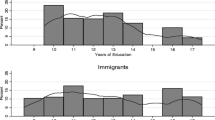Abstract.
Razin and Sadka (1999) show that unskilled immigration is beneficial to all income and all age groups in society, even if immigrants are net beneficiaries of the welfare system. Among other things, this result rests on the assumptions that immigrants have the same reproduction rate as the native population and that the immigrants’ offspring has the same distribution of skills as the natives’ offspring. By relaxing these assumptions, we show that the Razin and Sadka result is no longer unambiguous.
Similar content being viewed by others
Author information
Authors and Affiliations
Corresponding author
Additional information
Helpful comments and suggestions from two anonymous referees are gratefully acknowledged. Responsible editor: Alessandro Cigno.
Rights and permissions
About this article
Cite this article
Krieger, T. Fertility rates and skill distribution in Razin and Sadka’s migration-pension model: A note. J Popul Econ 17, 177–182 (2004). https://doi.org/10.1007/s00148-003-0170-1
Received:
Accepted:
Issue Date:
DOI: https://doi.org/10.1007/s00148-003-0170-1




